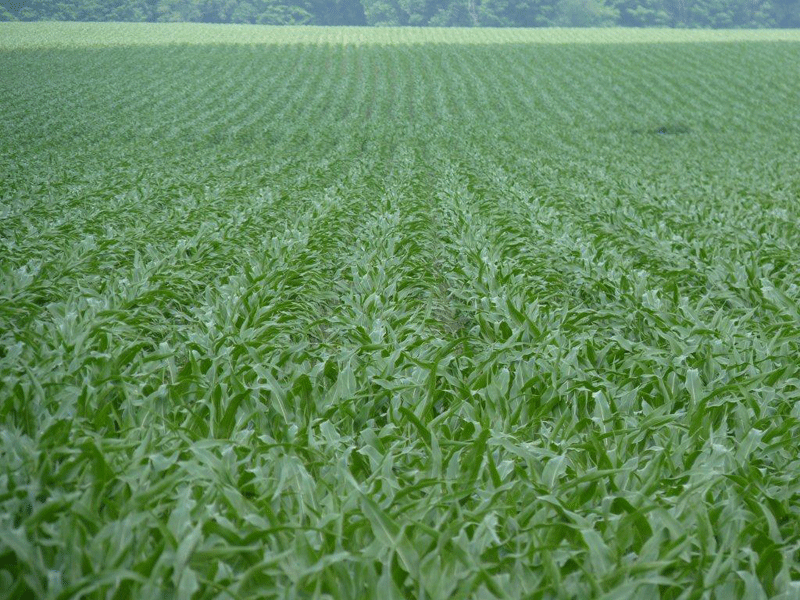Crop rotation pays off
IOWA RESEARCH CONFIRMS NET RETURNS
A TEN-YEAR FIELD study in central Iowa shows three- and four-year crop rotations achieving better net returns per acre than a two-year corn-soybean rotation, according to Dr. Matt Liebman, an Iowa State University (ISU) extension agronomy professor.

“Increasing cropping system diversity can be a viable strategy for reducing reliance on purchased inputs, suppressing weeds and certain diseases, improving soil quality, and maintaining yields and profits,” Liebman told Iowa farmers at winter workshops.
PERFORMANCE MEASURES
The study looked at multiple performance measures on 36 plots, each 60 by 275 feet. All phases of each rotation pattern — two- year corn and soybeans; three-year corn, soybeans, and oats/red clover; and four-year corn, soybeans, oats/alfalfa, and alfalfa (hay) — were present in each year of research.
Liebman reported a net return to land and management of $404 per acre (U.S.) for the corn/soy rotation, $420 for corn/soy/oats, and $433 for corn/soy/oats/alfalfa.
Multiple factors contributed to the difference in returns.
In the two-year rotation, researchers applied 100 pounds of nitrogen (N) at planting and side-dressed additional N based on soil test results. No N was applied at planting in the longer rotations. Instead, composted cattle manure was applied to red clover and alfalfa before corn, and N was side-dressed based on test results.
Mold-board plowing was not used in the spring during the two-year system but was used in the fall to incorporate red clover and alfalfa before rotating to corn.
Multiple tactics (cultivation, asynchronous harvests, stubble clipping, hay removal, and banded herbicides) in the more diversified systems reduced herbicide use.
As a result, average annual mineral N use per acre was 88% lower in the three-year rotation and 92% lower in the four-year system. Herbicide use dropped 96% and 97%, respectively.
Researchers also confirmed a reduction in soil erosion and an improvement in soil quality indicators. Estimated soil loss dropped from 1.36 tons per acre per year in the corn-soybean rotation to 1.08 tons in the three-year system and 0.88 tons in the four-year system.
Soil managed with longer rotations showed more particulate organic matter carbon, more microbial biomass carbon, and more potentially mineralizable nitrogen.
Average weed biomass was higher in the oat and alfalfa phases than in the corn and soybean phases, but the incidence and severity of sudden death syndrome in soybeans was dramatically higher in the two-year rotation.
Ultimately, the study’s corn plots achieved an average yield of 188 bushels per acre in rotation with soybeans, 194 bushels in the three year rotation, and 197 bushels in the four-year system. Soybean yields also increased from 47 bushels to 52 bushels and 55 bushels.
Oats yielded 93 bushel and 97 bushels respectively, and alfalfa produced 4.1 tons per acre.
TABLE: SOURCE – INPUTS COSTS FROM IOWA STATE UNIVERSITY EXTENSION. CROP PRODUCES FROM USDA-NATIONAL AGRICULTURAL STATISTICS SERVICE’S IOWA OFFICE.
| Labour and Economics (2008-2013) |
Rotation | ||
| 2 Year | 3 Year | 4 Year | |
| Labour inputs (hr/acre) | 0.7 | 1.1 | 1.5 |
| Gross return ($/acre) | 745 | 649 | 692 |
| Production costs (including labour ($/acre)) | 341 | 229 | 259 |
| Profits (returns to land and management ($/acre)) | 404 | 420 | 433 |
ENVIRONMENTAL BENEFITS
The study also assessed fossil energy use on a land area basis: 300 acres each of corn and soybeans; 200 acres each of corn, soybeans, and oats; and 150 acres each of corn, soybeans, oats, and alfalfa.
The diversified systems lowered energy input costs from 0.61 barrels of oil equivalent per acre to 0.24 and 0.26 barrels. Inputs in diesel fuel equivalent dropped from 25.4 gallons to 10.2 and 10.8 gallons. The major categories of use were nitrogen fertilizer, gas for corn drying, and tractor fuel.
Finally, researchers factored in economic assumptions and labour inputs, including cost and price data: an average corn price (2008 to 2013) of $5.12 per bushel, soybean price of $11.82, oat grain price of $3.21, oat straw price of $103 per ton, and alfalfa price of $154 per ton.
They concluded that the diversified rotations produced greater labour requirements and lower gross returns but also delivered lower costs and similar profits (see chart). Longer rotations also had less variation in net returns per acre.
More details on the ISU research are available at http://www.leopold.iastate.edu /faq-cropping-system-diversity-profitability. •






















